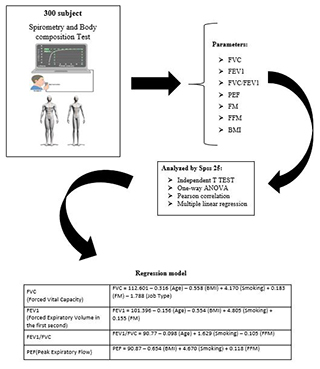Volume 11, Issue 2 (6-2021)
J Health Saf Work 2021, 11(2): 265-278 |
Back to browse issues page
Download citation:
BibTeX | RIS | EndNote | Medlars | ProCite | Reference Manager | RefWorks
Send citation to:



BibTeX | RIS | EndNote | Medlars | ProCite | Reference Manager | RefWorks
Send citation to:
Samiei S, Sadeghi Yarandi M, Pourbabaki R, Kalantary S, Golbabaei F. Evaluation of Factors Affecting Respiratory Function of Staff of Tehran University of Medical Sciences (TUMS). J Health Saf Work 2021; 11 (2) :265-278
URL: http://jhsw.tums.ac.ir/article-1-6502-en.html
URL: http://jhsw.tums.ac.ir/article-1-6502-en.html
Sajjad Samiei1 
 , Mohsen Sadeghi Yarandi1
, Mohsen Sadeghi Yarandi1 
 , Reza Pourbabaki2
, Reza Pourbabaki2 
 , Saba Kalantary1
, Saba Kalantary1 
 , Farideh Golbabaei *
, Farideh Golbabaei * 
 1
1

 , Mohsen Sadeghi Yarandi1
, Mohsen Sadeghi Yarandi1 
 , Reza Pourbabaki2
, Reza Pourbabaki2 
 , Saba Kalantary1
, Saba Kalantary1 
 , Farideh Golbabaei *
, Farideh Golbabaei * 
 1
1
1- Department of Occupational Health Engineering, School of health, Tehran University of medical sciences, Tehran, Iran
2- Department Occupational Health Engineering, School of Public Health, Shiraz University of Medical Sciences, Shiraz, Iran l Department of Occupational Health Engineering, School of Public Health, Kerman University of Medical Sciences, Kerman, Iran
2- Department Occupational Health Engineering, School of Public Health, Shiraz University of Medical Sciences, Shiraz, Iran l Department of Occupational Health Engineering, School of Public Health, Kerman University of Medical Sciences, Kerman, Iran
Abstract: (7420 Views)
Introduction: The respiratory system, one of the most important organs of the body, can be affected by adverse effects, disorders and consequences in the workplace. Spirometry is one of the most important screening and testing tools in the periodic medical examination of every employee. This study was aimed to evaluate the factors affecting the respiratory function of staff of Tehran University of Medical Sciences (TUMS).
Material and Methods: This descriptive-analytical and cross-sectional study carried out on 300 employees of TUMS according on during the enrollment phase of the Tehran University of Medical Sciences employee’s cohort (TEC) study was in order to survey the parameters affecting pulmonary function. Demographic data were collected through a demographic questionnaire. Spirometry was used to evaluate respiratory function parameters and bioelectric impedance was used to analyze body composition. Data analysis was performed by SPSS software version 25. Two-sample t-test, one-way ANOVA, and Pearson correlation coefficient were used for statistical analysis. Multiple linear regression was used to determine the effect of independent variables on the parameters of pulmonary function.
Results: It was found that 73.6% of the subjects had a normal lung pattern, 7% had an obstructive pattern, 14.7% had a threatening pattern and 4.7% had a mixed pattern. There was a significant negative correlation between FVC and FEV1 parameters and smoking (P-value <0.05). There was also a significant relationship between FFM, age and BMI with FEV1/FVC (P-value <0.05). Similarly, there was a meaningful relationship between type of job and FVC parameter (P-value <0.05). The findings showed that the highest and the lowest averages of all parameters of pulmonary function was in administrative and occupational services, public and technical services and facilities, security and guard, respectively.
Conclusion: In the present study, it was found that occupation type affects lung function due to exposure to contaminants in different groups. Other factors affecting lung function included age, body mass index, fat mass, fat free mass and smoking. Therefore, changing lifestyle such as proper diet, regular exercise and not smoking can be an effective step towards improving the parameters of lung function.
Material and Methods: This descriptive-analytical and cross-sectional study carried out on 300 employees of TUMS according on during the enrollment phase of the Tehran University of Medical Sciences employee’s cohort (TEC) study was in order to survey the parameters affecting pulmonary function. Demographic data were collected through a demographic questionnaire. Spirometry was used to evaluate respiratory function parameters and bioelectric impedance was used to analyze body composition. Data analysis was performed by SPSS software version 25. Two-sample t-test, one-way ANOVA, and Pearson correlation coefficient were used for statistical analysis. Multiple linear regression was used to determine the effect of independent variables on the parameters of pulmonary function.
Results: It was found that 73.6% of the subjects had a normal lung pattern, 7% had an obstructive pattern, 14.7% had a threatening pattern and 4.7% had a mixed pattern. There was a significant negative correlation between FVC and FEV1 parameters and smoking (P-value <0.05). There was also a significant relationship between FFM, age and BMI with FEV1/FVC (P-value <0.05). Similarly, there was a meaningful relationship between type of job and FVC parameter (P-value <0.05). The findings showed that the highest and the lowest averages of all parameters of pulmonary function was in administrative and occupational services, public and technical services and facilities, security and guard, respectively.
Conclusion: In the present study, it was found that occupation type affects lung function due to exposure to contaminants in different groups. Other factors affecting lung function included age, body mass index, fat mass, fat free mass and smoking. Therefore, changing lifestyle such as proper diet, regular exercise and not smoking can be an effective step towards improving the parameters of lung function.
Type of Study: Research |
Received: 2021/06/12 | Accepted: 2021/06/12 | Published: 2021/06/12
Received: 2021/06/12 | Accepted: 2021/06/12 | Published: 2021/06/12
| Rights and permissions | |
 |
This work is licensed under a Creative Commons Attribution-NonCommercial 4.0 International License. |




